My Body is Still in Madrid
It was over a year in the making. The discussion went from which cities to include, how many days, spring break or summer and budgeting. Should we sign up for a package tour, putting the onus on guides and agents to find lodging and enroll us in the “skip the line” deals at museums? With five of us, the cost rose exponentially. Round trip airfare, hotels and, unbeknownst to us, taxi rides limited to four occupants. That would come later.
My son, Greg, wanted to take his family to Spain and gratefully, while I was still in the picture! His family consists of wife, Cindy, and two kids, James, aged 9, and Ella, 13. How would the kids react to being in another country, with another language, and especially different foods? James is a self-described “picky” eater! Would he starve?
We settled on spring break, despite the extra expense and crowds that would be present during Holy Week. Greg and I listed locations from all over the Iberian Peninsula then, judiciously placed them on a schedule of rational times and distances which resulted in, what I call, The Madrid Environs, plus Seville. I was fascinated as Greg perused his computer, finding a perfectly located VRBO, (Vacation Rental by Owner – new idea to me), in Madrid, and a home with pool in Seville away from the all-night processions. Then, we booked Toledo, Avila, Segovia and Granada around our pivot points.
Travel is such a metaphor for life. Each step is where you are at until the next step reveals options. Our precise plans were immediately sidelined when the first plane was delayed, resulting in missing our connection in Amsterdam. They sent us through Paris to get to Madrid, again proving the only thing we control is our attitude.
Planes feel like time capsules to me, reconfiguring us into a reality of movies, pretend food, and a seat-belted space that even I find confining. After nine or more hours, we are disgorged from this metal tube into an open space, this time filled with centuries old architecture, massive fountains inside of roundabouts, tree-lined boulevards, and blurs of taxis. Our native English vanished into a din of world languages, occasionally reappearing as snippets received when passing pedestrians, like a radio dial being spun around, caught an English station.
Our suitcases rumbled behind us on the cobblestone of Calle de las Huertas. Greg, who had traveled to Madrid for the first time when he was eight, led the way, with me being the “sweeper” for any straggler. We came to Number 65, rang the bell and then climbed, yes climbed, the three flights of shiny, worn wooden stairs to our new home, welcomed by Domingo and Ana, the owners.
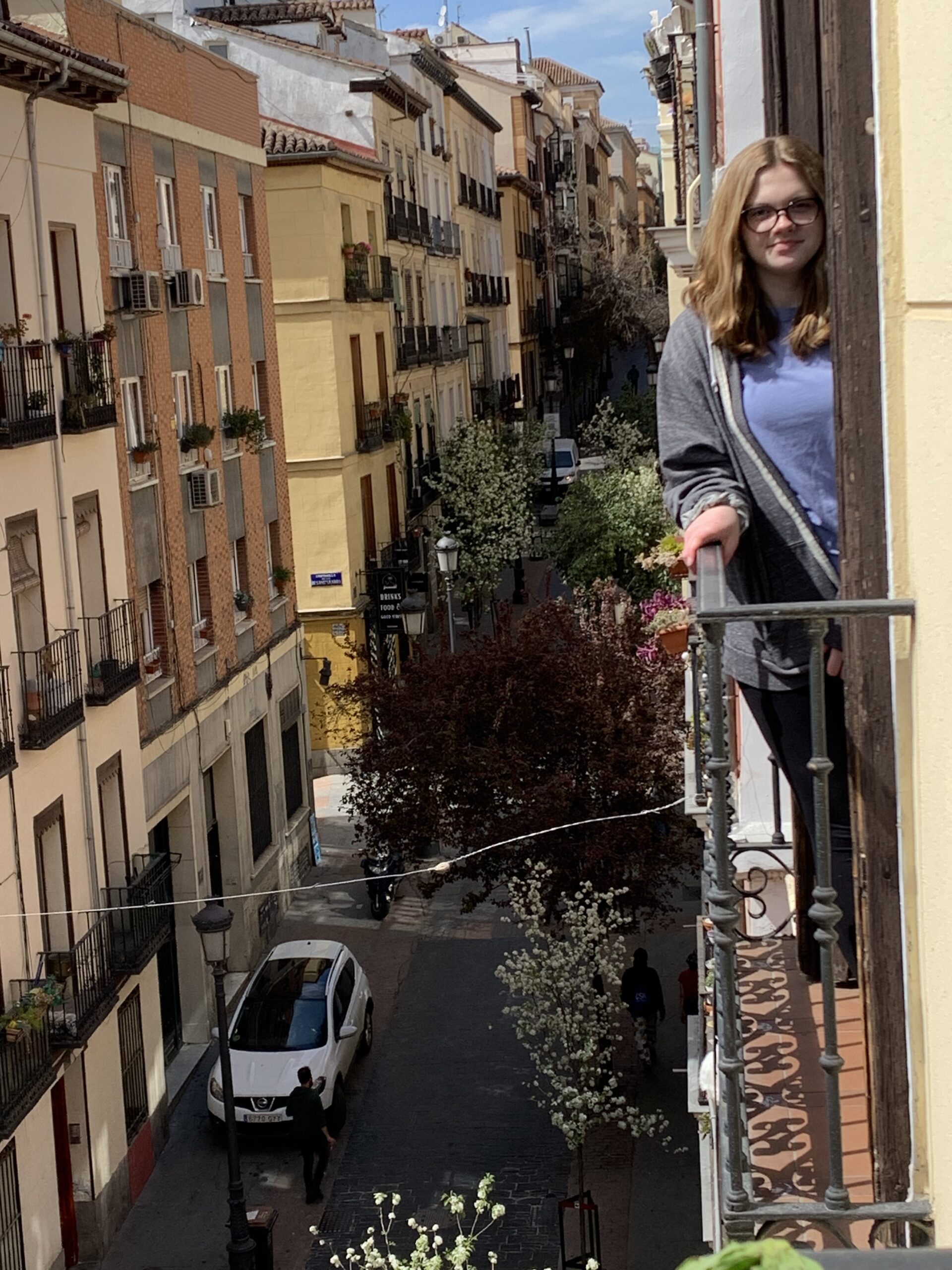
They gave us a tour, two keys, and pointed out the maps marked with grocery stores and cafes. Bedrooms were quickly claimed and . . . we flung open the 12’ wooden shutters and walked out onto our balconies. The “movida” movement of people flowed below us on the walk marked with poetry and famous quotes below their feet. Across the ten-foot sidewalk, we entered our hole-in-the-wall grocery. Down the street, outdoor cafes, a small park for toddlers popped up on the wato the Paseo del Prado at the bottom of the hill. Inside the “piso” (apartment), walls were filled with artwork, wooden floors, antiques, and curiosities – a real feel Madrid apartment!
In the next days, we would eat tapas around this table with Aser and Manu, two brothers who had spent time in Brainerd over twenty years ago! The kids would learn how to grocery shop with the four-wheeled plastic grocery carts, drug behind like a dog on a chain. They tried bolillo bread, milk with pull dates three months out, a pomegranate, and distinguished between jamón ibérico and jamón serrano. According to the guide, the former comes from black, “happy” pigs, free range feeding on acorns, while the latter comes from white pigs with confined diet and living quarters.
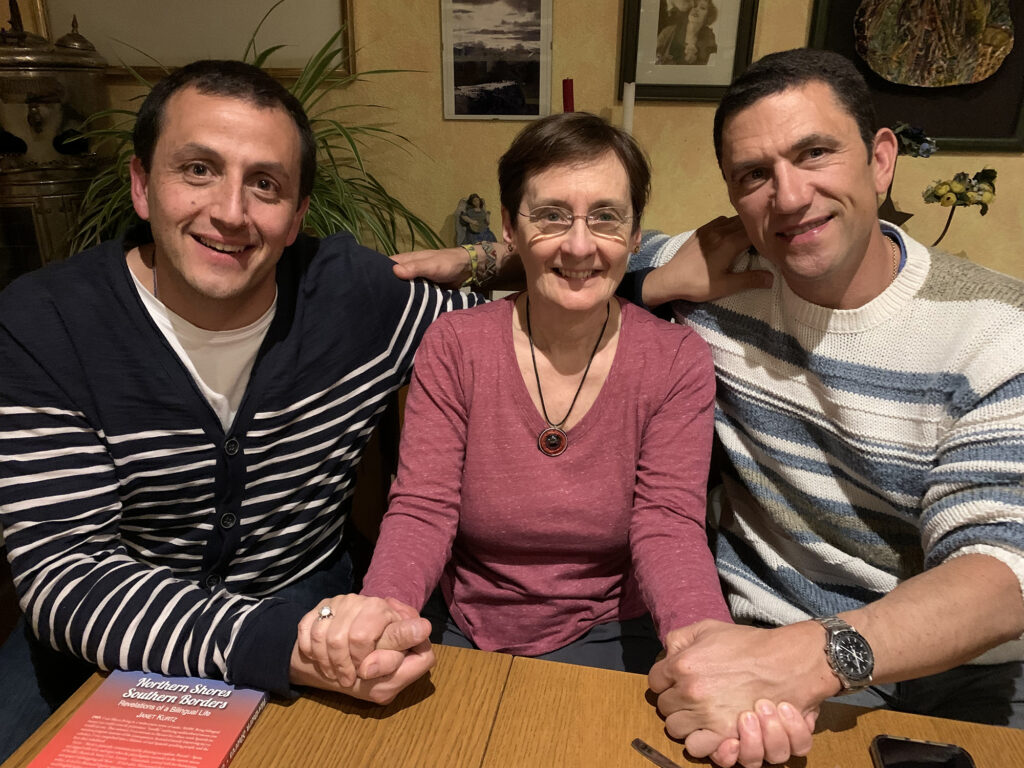
From our nest in Old Madrid, the Prado Museum was a ten-minute walk, with five more to the Parque Retiro. In the opposite direction, fifteen minutes got us to the Plaza Mayor, with an extra ten putting us at the Royal Palace. We walked everywhere. The kids carried their small backpack with personal water and sandwich, some money and a laminated card with their local address and my WhatsApp number.
Like Columbus discovering a “new world,” they “discovered” El Greco’s bright blues and red religious paintings, Goya’s Maja Desnuda, (What would Governor DeSantis think!?) and Velazquez’ Las Meninas – a print I had framed and given to them years ago. Only, in the Prado, it towered above them and clearly showed the mastery of the artist using mirror images. I make the DeSantis reference, due to the bruhaha over DeVinci’s nude David when we left the country.
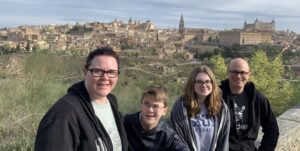
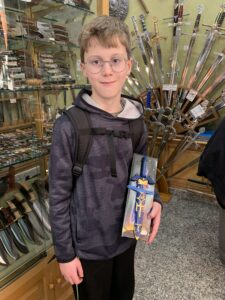
Toledo was our first day trip, planned with swords in mind. We boarded the bus and were taken around Toledo’s perimeter for the famous Vista de Toledo painted by El Greco – mandatory photo stop. The streets narrowed and the history of Spain’s first capital reflected the coexistence of Jewish, Moorish, and the Christian peoples, until the Reconquest. (Spoiler: Enter Queen Isabel and husband, Ferdinand, 1492, for the full Reconquista and ousting of all non-converts followed by a three- hundred-year, world-wide Inquisition.)
Twice that day, James turned to me and whispered, “This is a dream come true.” First, when he stood before a master sword maker forging a piping hot Toledo blade and second, when he held his own purchase – a replica Master dagger from Zelda, a very important video game! My son was equally pleased with a replica, Orcrist (Goblin-cleaver) sword from Hobbit fame. I was unprepared for iconic movies to be the source of wonder. Segovia’s alcazar, the prototype for Walt Disney’s Tinkerbell castle, Frodo and Gandolf swords plus the Roman ruins of Italica backdrop to Game of Thrones? Really? Not my reference points, but evidently valid.
I had traveled these cities as a bright-eyed teenager, as a well-worn Spanish teacher with my students, as a mother to my then eight-year-old son when I studied a month in Madrid, and as a daughter, finally returning to my favorite places with my mother when she was 72. I now returned as an “abue”- what does a “grandma” trip entail?
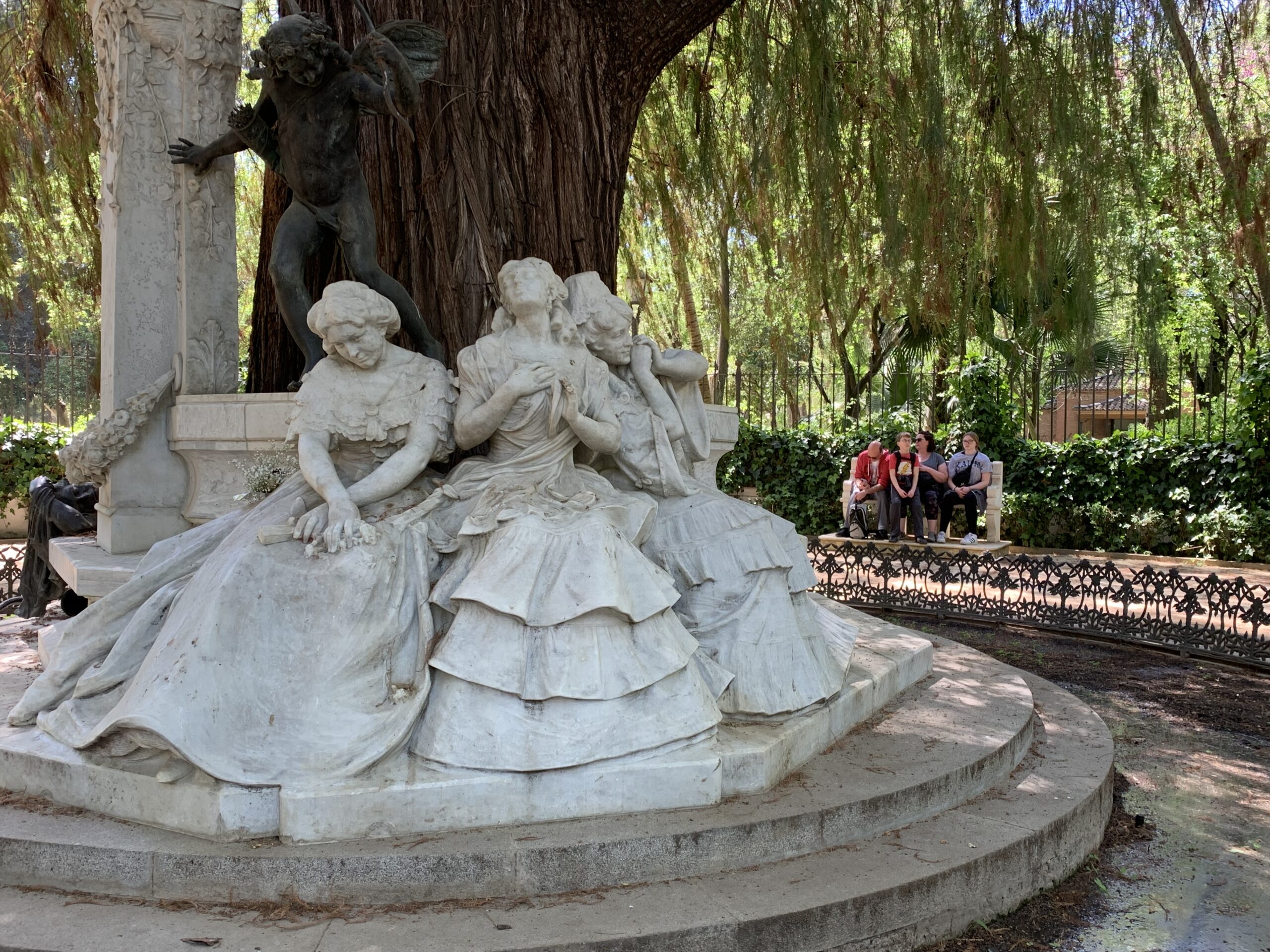
The Bequer statues in Seville’s Maria Luisa Park are the same, but showing signs of moss. The Alhambra’s Patio de los Leones is chained off so we can no longer drink from the lion’s spouting water with the promise of a sure return to Spain. Santa Teresa’s finger is still in a box in Avila. It seems finally settled, that Columbus is buried in the third largest cathedral in the world and not on some Caribbean island.
We’ve been home for less than a week. The coming conversations will reveal our inner trip. To remember things as we get thrown back into the fray, Ella and I made a list. Twister popsicles, Fernando, the ultimate caballero of hospitality in Seville, La Andaluza’s calamares tapas, the Alhambra’s honeycomb ceilings, and the white cat from Calle Gaspar Perez de Villagran, hunkered amongst the brilliant pink bougainvilleas. No, James, we cannot take the kitty home.
Today, James announced, “I am home again. I know it isn’t lunch time, but my body thinks it’s in Madrid and I am hungry!”
Yes, today, we’re settling back in and James is spot on. It is 3:00 a.m. and my body thinks I’m still in Madrid!
And to leave you with a few moments of this year’s Easter Processions in Toledo and Seville.

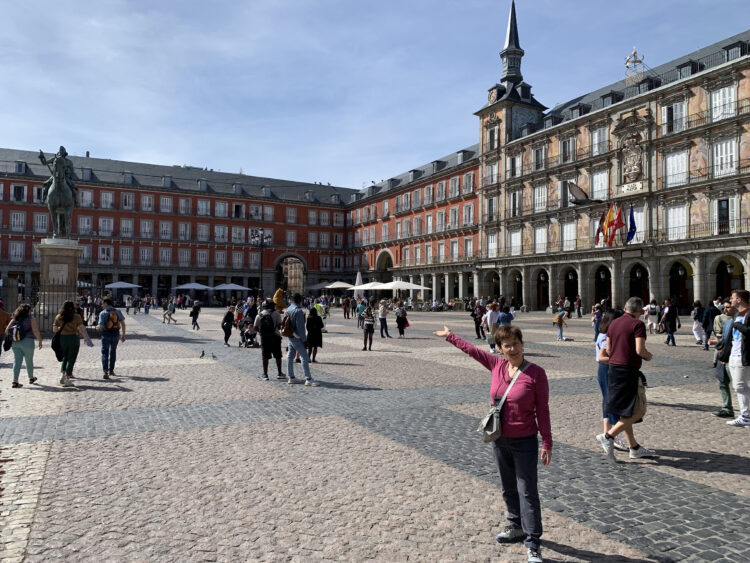
Jan, you are the “funnest” grandma ever!! I traveled to Spain in about 1970 with my then mother-in-law, her sister, and her granddaughter, age 16, who couldn’t stand to be separated from her boyfriend for the week. I thought I’d never make it home. I should sign up to go with you.
PK
Oh, Penny, Great to hear from you and that you had a chance at Spain. I was concerned, as both grandkids have been jittery about being away from home. . . even with their parents along. When our flights over got delayed, rerouted (to Paris, with an air glimpse of the Eiffel Tower) and late arrival at Madrid, they were ready to go home right then! So pleased we got back on course. One of the special parts of this trip was the comparison of going as a University student, a newly married wife, a mom with her 8-year-old son, returns with friends, then with mom (at 72), and now seeing these places through the eyes of Cindy and the kids. I think you need another chance!!! Jan K.
hola Tía Jan!!! me parece maravilloso que en éste viaje tuviste la oportunidad de volver, recordar y disfrutar de lugares tan mágicos. Considero que fué una gran experiencia el poder vivir de nuevo esos lugares desde otra perspectiva, agregando ahora la faceta de abuela. ¿Qué fué lo mejor se vivir éste recorrido 20 años después como abuela?
Besos, Marina!
Saludos, Marina, para ti y para tu madre y tu abuela – hablando de generaciones! Que bien es compartir contigo por medio de este website. Habra mas historias y fotos, a lo mejor, en el futuro. Viajar es una maravilla, y tu vas pronto a realizar tus metas! Y, si es por el norte, aqui tienes casa. Si Minnesota no te apetece pues, en otro sito nos reunirermos, eh? Y a ti, mas besos!! Jan
Thank you for sharing your travel adventures with us, Jan. Such a fun and interesting journey! I loved seeing your family and friends. Wonderful that you could enjoy this special time together.
Gracias, Lauren. It means so much to me that you come along on my “writing” journeys. I’m wondering what more to do with this latest adventure. I hope to get more “raw” input from the kids, to see it through their eyes. That way, I will rediscover. I need to practice that intention just driving to town! Buen dia, amiga!
Thanks for the trip blog! It reminded me of the trip I took with two of my daughters quite a few years ago. We were there in the summer, however, so no Easter parade or fiestas. Your photos brought back memories, however.
Nan
Thank you for another fun and interesting La Pluma ! I am a little confused by Rick Stevens: is Macarena also Mary or are they two different women ?
I am currently in Ajijic Mexico and spent two days near Easter following Jesus around town as he was betrayed and condemned and crucified. Fascinating !
Keep enriching us !
Stefani, I got your letter about being in Mexico and you’ll have an answer waiting whenever you get home!
As to the Mary business. I asked a friend from Seville to explain. Antonio told me that, like each of us, we all have many facets to our personality, if not in fact, roles we play. Example: Mom, daughter, wife, professional, neighbor etc. I was confused at all the Virgenes in Seville alone, you see. I lived on Calle de la Virgen de Lujan; Triana had streets and churches, plus the Macarena and, and. . .
Each of these represents a characteristic or “facet” of the ONE Virgin Mary. The Macarena is a part of the intense grief at Good Friday, as well as a guardian of that neighborhood, bullfighters and gypsies. Do with this what you will!
Abrazos,
Jan
Nan, I guess I didn’t recall your “viaje a Espana” with your kiddos. Today, April 19, is Ella’s 14th birthday. I asked her what she wanted and she replied, “to travel to Europe with my friends.” Maybe not today, but the seed is planted!!
Good to hear from you, Nan.
Sounds like a wonderful trip. We enjoyed your article about it Charlotte and Walt
Saludos Charolotte and Walt! You are world travelers, so you would know a good trip! So pleased you are traveling vicariously with me now. Thanks for following me around!
Big hugs and much happiness as you “travel” around your acreage this spring!